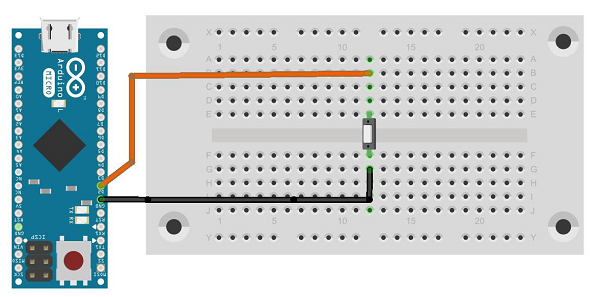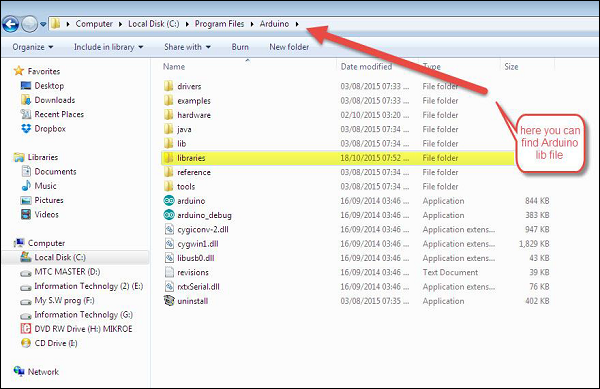This example uses the Keyboard library to log you out of your user session on your computer when pin 2 on the ARDUINO UNO is pulled to ground. The sketch simulates the keypress in sequence of two or three keys at the same time and after a short delay, it releases them.
Warning − When you use the Keyboard.print() command, Arduino takes over your computer's keyboard. To ensure you do not lose control of your computer while running a sketch with this function, set up a reliable control system before you call Keyboard.print(). This sketch is designed to only send a Keyboard command after a pin has been pulled to ground.
Components Required
You will need the following components −
- 1 × Breadboard
- 1 × Arduino Leonardo, Micro, or Due board
- 1 × pushbutton
- 1 × Jumper
Procedure
Follow the circuit diagram and hook up the components on the breadboard as shown in the image below.

Sketch
Open the Arduino IDE software on your computer. Coding in the Arduino language will control your circuit. Open a new sketch File by clicking New.
For this example, you need to use Arduino IDE 1.6.7

Note − You must include the keyboard library in your Arduino library file. Copy and paste the keypad library file inside the file with the name libraries (highlighted) as shown in the following screenshot.

Arduino Code
/* Keyboard logout This sketch demonstrates the Keyboard library. When you connect pin 2 to ground, it performs a logout. It uses keyboard combinations to do this, as follows: On Windows, CTRL-ALT-DEL followed by ALT-l On Ubuntu, CTRL-ALT-DEL, and ENTER On OSX, CMD-SHIFT-q To wake: Spacebar. Circuit: * Arduino Leonardo or Micro * wire to connect D2 to ground. */ #define OSX 0 #define WINDOWS 1 #define UBUNTU 2 #include "Keyboard.h" // change this to match your platform: int platform = WINDOWS; void setup() { // make pin 2 an input and turn on the // pullup resistor so it goes high unless // connected to ground: pinMode(2, INPUT_PULLUP); Keyboard.begin(); } void loop() { while (digitalRead(2) == HIGH) { // do nothing until pin 2 goes low delay(500); } delay(1000); switch (platform) { case OSX: Keyboard.press(KEY_LEFT_GUI); // Shift-Q logs out: Keyboard.press(KEY_LEFT_SHIFT); Keyboard.press('Q'); delay(100); // enter: Keyboard.write(KEY_RETURN); break; case WINDOWS: // CTRL-ALT-DEL: Keyboard.press(KEY_LEFT_CTRL); Keyboard.press(KEY_LEFT_ALT); Keyboard.press(KEY_DELETE); delay(100); Keyboard.releaseAll(); //ALT-l: delay(2000); Keyboard.press(KEY_LEFT_ALT); Keyboard.press('l'); Keyboard.releaseAll(); break; case UBUNTU: // CTRL-ALT-DEL: Keyboard.press(KEY_LEFT_CTRL); Keyboard.press(KEY_LEFT_ALT); Keyboard.press(KEY_DELETE); delay(1000); Keyboard.releaseAll(); // Enter to confirm logout: Keyboard.write(KEY_RETURN); break; } // do nothing: while (true); } Keyboard.releaseAll(); // enter: Keyboard.write(KEY_RETURN); break; case WINDOWS: // CTRL-ALT-DEL: Keyboard.press(KEY_LEFT_CTRL); Keyboard.press(KEY_LEFT_ALT); Keyboard.press(KEY_DELETE); delay(100); Keyboard.releaseAll(); //ALT-l: delay(2000); Keyboard.press(KEY_LEFT_ALT); Keyboard.press('l'); Keyboard.releaseAll(); break; case UBUNTU: // CTRL-ALT-DEL: Keyboard.press(KEY_LEFT_CTRL); Keyboard.press(KEY_LEFT_ALT); Keyboard.press(KEY_DELETE); delay(1000); Keyboard.releaseAll(); // Enter to confirm logout: Keyboard.write(KEY_RETURN); break; } // do nothing: while (true); }
Code to Note
Before you upload the program to your board, make sure you assign the correct OS you are currently using to the platform variable.
While the sketch is running, pressing the button will connect pin 2 to the ground and the board will send the logout sequence to the USB connected PC.
Result
When you connect pin 2 to the ground, it performs a logout operation.
It uses the following keyboard combinations to logout −
- On Windows, CTRL-ALT-DEL followed by ALT-l
- On Ubuntu, CTRL-ALT-DEL, and ENTER
- On OSX, CMD-SHIFT-q